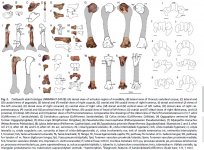Fred Ruhe
Well-known member

Daniel T. Ksepkaa, Thomas A. Stidham & Thomas E. Williamson, 2017
Early Paleocene landbird supports rapid phylogenetic and morphological diversification of crown birds after the K–Pg mass extinction
Proceedings of the National Academy of Sciences (advance online publication)
doi: 10.1073/pnas.1700188114
http://www.pnas.org/content/early/2017/07/05/1700188114.abstract
Significance:
Molecular (DNA) studies suggest that birds radiated rapidly in the wake of the Cretaceous–Paleogene mass extinction (66 Ma), diversifying into nearly all the major groups we recognize today. However, fossil evidence for this pattern has been difficult to find because of the poor fossilization potential of small, delicate-boned birds. We report a tiny species of bird from ~62.5 million-year-old rocks in New Mexico. Tsidiiyazhi abini (Navajo for “little morning bird”) is an ancient species of mousebird (Coliiformes). The fossil provides evidence that many groups of birds arose just a few million years after the mass extinction and had already begun evolving specializations of the foot for different ecological roles.
Abstract:
Evidence is accumulating for a rapid diversification of birds following the K–Pg extinction. Recent molecular divergence dating studies suggest that birds radiated explosively during the first few million years of the Paleocene; however, fossils from this interval remain poorly represented, hindering our understanding of morphological and ecological specialization in early neoavian birds. Here we report a small fossil bird from the Nacimiento Formation of New Mexico, constrained to 62.221–62.517 Ma. This partial skeleton represents the oldest arboreal crown group bird known. Phylogenetic analyses recovered Tsidiiyazhi abini gen. et sp. nov. as a member of the Sandcoleidae, an extinct basal clade of stem mousebirds (Coliiformes). The discovery of Tsidiiyazhi pushes the minimum divergence ages of as many as nine additional major neoavian lineages into the earliest Paleocene, compressing the duration of the proposed explosive post–K–Pg radiation of modern birds into a very narrow temporal window parallel to that suggested for placental mammals. Simultaneously, Tsidiiyazhi provides evidence for the rapid morphological (and likely ecological) diversification of crown birds. Features of the foot indicate semizygodactyly (the ability to facultatively reverse the fourth pedal digit), and the arcuate arrangement of the pedal trochleae bears a striking resemblance to the conformation in owls (Strigiformes). Inclusion of fossil taxa and branch length estimates impacts ancestral state reconstructions, revealing support for the independent evolution of semizygodactyly in Coliiformes, Leptosomiformes, and Strigiformes, none of which is closely related to extant clades exhibiting full zygodactyly.
Etymology:
The genus and species names are derived from the Navajo (Diné Bizaad) language, reflecting the discovery of the fossil within ancestral Navajo lands. The genus name is derived from the words “tsidii” for “bird” and “yazhi” for “little,” in reference to the fossil’s small size. The specific epithet is derived from the Navajo word “abini” for “morning,” referencing the early Paleocene age of the taxon. Pronunciation using International Phonetic Alphabet phonetic symbols is as follows: /tsɪdi:jæʒi:/ /′ɔbɪnɪ/.
Enjoy,
Fred
Early Paleocene landbird supports rapid phylogenetic and morphological diversification of crown birds after the K–Pg mass extinction
Proceedings of the National Academy of Sciences (advance online publication)
doi: 10.1073/pnas.1700188114
http://www.pnas.org/content/early/2017/07/05/1700188114.abstract
Significance:
Molecular (DNA) studies suggest that birds radiated rapidly in the wake of the Cretaceous–Paleogene mass extinction (66 Ma), diversifying into nearly all the major groups we recognize today. However, fossil evidence for this pattern has been difficult to find because of the poor fossilization potential of small, delicate-boned birds. We report a tiny species of bird from ~62.5 million-year-old rocks in New Mexico. Tsidiiyazhi abini (Navajo for “little morning bird”) is an ancient species of mousebird (Coliiformes). The fossil provides evidence that many groups of birds arose just a few million years after the mass extinction and had already begun evolving specializations of the foot for different ecological roles.
Abstract:
Evidence is accumulating for a rapid diversification of birds following the K–Pg extinction. Recent molecular divergence dating studies suggest that birds radiated explosively during the first few million years of the Paleocene; however, fossils from this interval remain poorly represented, hindering our understanding of morphological and ecological specialization in early neoavian birds. Here we report a small fossil bird from the Nacimiento Formation of New Mexico, constrained to 62.221–62.517 Ma. This partial skeleton represents the oldest arboreal crown group bird known. Phylogenetic analyses recovered Tsidiiyazhi abini gen. et sp. nov. as a member of the Sandcoleidae, an extinct basal clade of stem mousebirds (Coliiformes). The discovery of Tsidiiyazhi pushes the minimum divergence ages of as many as nine additional major neoavian lineages into the earliest Paleocene, compressing the duration of the proposed explosive post–K–Pg radiation of modern birds into a very narrow temporal window parallel to that suggested for placental mammals. Simultaneously, Tsidiiyazhi provides evidence for the rapid morphological (and likely ecological) diversification of crown birds. Features of the foot indicate semizygodactyly (the ability to facultatively reverse the fourth pedal digit), and the arcuate arrangement of the pedal trochleae bears a striking resemblance to the conformation in owls (Strigiformes). Inclusion of fossil taxa and branch length estimates impacts ancestral state reconstructions, revealing support for the independent evolution of semizygodactyly in Coliiformes, Leptosomiformes, and Strigiformes, none of which is closely related to extant clades exhibiting full zygodactyly.
Etymology:
The genus and species names are derived from the Navajo (Diné Bizaad) language, reflecting the discovery of the fossil within ancestral Navajo lands. The genus name is derived from the words “tsidii” for “bird” and “yazhi” for “little,” in reference to the fossil’s small size. The specific epithet is derived from the Navajo word “abini” for “morning,” referencing the early Paleocene age of the taxon. Pronunciation using International Phonetic Alphabet phonetic symbols is as follows: /tsɪdi:jæʒi:/ /′ɔbɪnɪ/.
Enjoy,
Fred




